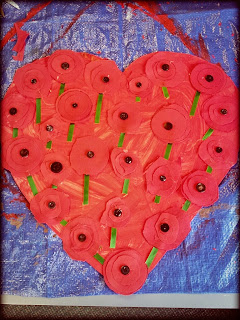My current school recognises ANZAC Day (Remembrance Day) every year with a whole school assembly as close to the 25th of April as we can. The local RSA members come along and each class lays a 'wreath' dedicated to our fallen soldiers. The whole effect is just beautiful, and every year I am blown away by the variety of crafts each class presents.
This year we worked with our buddy class to create some layered fabric poppies. I got the inspiration from this site here.
Originally I had high ambitions and wanted the children to sew layers of eco-cloth together to create the poppies. My hopes were quickly dashed, and we resorted to hot glue gunning the layers together. Nice and fast and probably more effective... most sewn efforts were a disaster.
We keep our hot glue guns on plastic plates. The plates catch the drips and when the children glue the gun to the plate, it easily peels back off again.
The class then brainstormed how we wanted to present our poppies. We chose to glue them to a large cardboard heart, which the children painted red.
The poppies were glued on the front.
The class also decided to write a letter to the soldiers to go on the back. We all 'signed' the letter with a red paint fingerprint, which I then turned into poppies with the help of a couple of felt tip pens. Gorgeously effective!
I thoroughly recommend using eco-cloth. It is $4.99p/m at Spotlight. The cloth is easy to cut with children's scissors and does not fray. It comes in a wide range of great colours and is a good backdrop for wall displays. Will definitely buy this stuff again!
I find Math to be an absolute headache in terms of resource management. There is never enough resources, occasionally too many, and they are often in bad repair. This is why my next few posts are about Math resources. Enjoy! As I teach in NZ and follow the Numeracy Projects, place value houses are a common material to work with. I printed mine off A4 size from http://www.nzmaths.co.nz/sites/default/files/Numeracy/2007matmas/Bk4/MM%204_11.pdf . Each 'house' was copied onto a different coloured paper, and then cut out and laminated. I didn't cut them out again after laminating, as it made it easier to punch a hole in the corner and thread a ring through (are they 'magazine' rings?). My awesome set can now hang from the wall if there is space. No more scrunching up in the bottom of a drawer! They are also really quick and easy to unclip and use, then pack up again. I started off using a whiteboard pen to write the digits directly onto the laminated charts...





Comments
Post a Comment